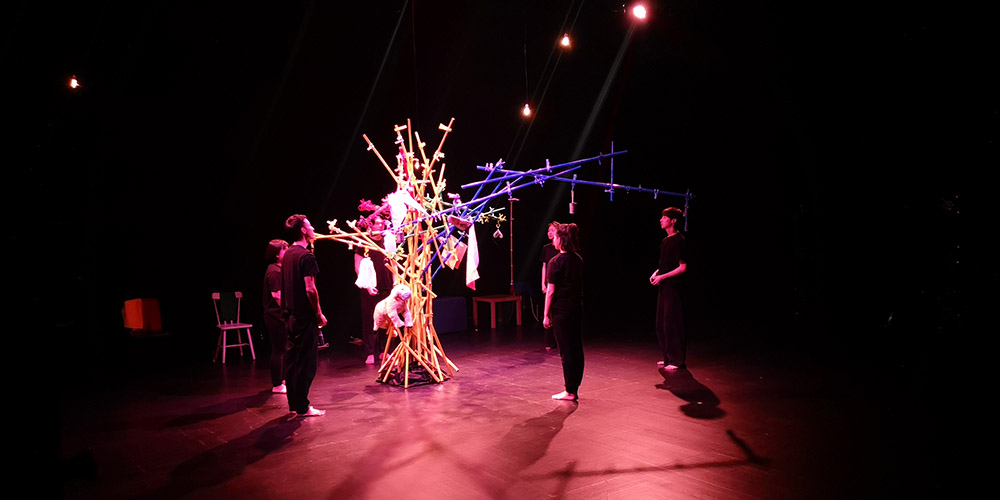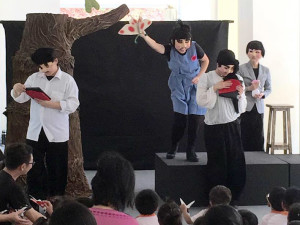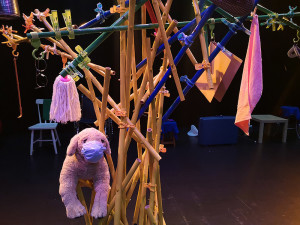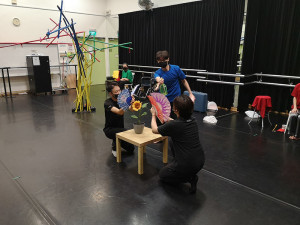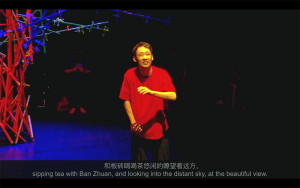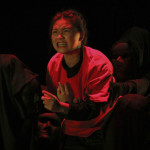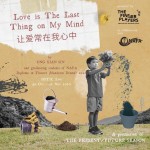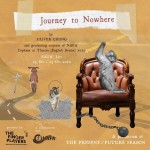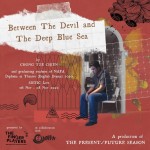Love Is The Last Thing On My Mind 让爱常在我心中 was one of the four theatre productions presented by The Finger Players (TFP) in collaboration with Nanyang Academy of Fine Arts (NAFA). It has been a pleasure and honour to document this work and its creation process, as I recalled my previous encounters with this play.
The original play (written by Ang Hui Bin) was created in 2015 as a community performance which toured various elderly care centres and charity organisations. I remember watching this version as an audience member at a void deck, sitting behind a group of preschool children. As a preschool educator myself, I was initially sceptical about the show’s ability to engage children due to their short attention span. As I witnessed how the children could remain seated for thirty minutes straight and stay focused throughout, I was deeply moved by how the piece could transcend language and age. The senior citizens in the audience were similarly engaged. The 2015 version was multilingual and included performance elements like mask, pantomime, and puppetry.
Right after the community tour, Love is the Last Thing on My Mind was adapted for schools and toured various educational institutions as an assembly play. I became one of the cast members during the school tours in 2017. I was once again moved by this collection of stories that questioned the value of love and concern in modern society.
This year, Director Ong Kian Sin (Core Team Member of The Finger Players) chose to restage this script as he felt that it captured the essence of TFP’s signature style. With creative input from the graduating students of NAFA’s Diploma in Theatre (Mandarin Drama), Love is the Last Thing on My Mind evolved once again and underwent a beautiful transformation, much like the caterpillar (Maomao) in the play.
The creation process started from a distance due to the COVID-19 pandemic. The first meeting between the director and cast members happened over the virtual Zoom platform on 12 Aug 2020. Kian Sin was back home in Malaysia, while many of the cast members were in China. During the two weeks of virtual rehearsals, Kian Sin introduced new dramatic forms, such as physical theatre and object puppetry, to the NAFA students. He also trained the students to work with the framing on screen as they moved their bodies and explored manipulating the different objects. Students then learnt to tell stories using objects and created their own monologues. It was also on the Zoom platform where they had their first script read.
Eventually, three other NAFA students were unable to make it back to Singapore to participate in this graduating performance. The team had to work with a final cast strength of six, and physical rehearsals finally began on the NAFA campus from 26 August 2020 onwards. Even so, one of the cast members, Wang Zhenni, only managed to join the physical rehearsals from 16 September onwards. Both the production and creative teams worked intensely due to the rehearsal time lost from being physically apart. With about 1.5 months left to the performance, Kian Sin started to rehearse the play while continuing to train the actors’ body language.
In my documentation process, I attended two rehearsals on the NAFA campus, and interviewed the director and the cast members. I also watched the full-dress rehearsal in the theatre space and the digital version on the SISTIC live platform.
New Creative Inputs to Old Script
When I entered the rehearsal space for the first time on 14 Oct 2020, what immediately caught my eye was the colourful tree-like structure made up of bamboo poles. Kian Sin mentioned that the bamboo poles reminded him of Singapore’s public housing estates where people use these bamboo poles to hang their laundry outside the windows.
Hanging on the structure were various household items, such as a plastic spray bottle, a mop head, tin cans and clothes pegs. Upon interviewing Kian Sin, I found out that he intentionally focused on the use of objects that can be found in everyday life to tell stories. There were minimal modifications to each object, except the addition of some mechanisms to help with object puppetry. For instance, the pair of slippers that were used as a butterfly underwent two modifications. Daniel Sim (Puppet, Props and Set Maker) removed the soles of the slippers and replaced them with thinner pieces of soft foam, which allowed more flexibility. A key ring was added in the middle and the two slippers were stitched together, so that the slippers could be hung on the tree and the puppeteer could hold and manipulate the slipper-butterfly more easily.
I also quickly recognised the caterpillar (one of the main characters in the play) as the cast (Wang Zhenni) breathed life into the flat bright orange microfiber mop head by synchronizing her own visual focus and physical movements with the caterpillar’s movement. I also witnessed how foldable fans, an eye mask, and even a pair of bedroom slippers, could become butterflies through object puppetry.
As I interviewed the cast members, I learnt that for most of them, it was their first exposure to object theatre. One of the cast members, Sun Zhenyu, said the process was difficult but also magical for him:
“我觉得还蛮神奇的。因为它就是我们一些生活用品…我们好像赋予它生命一样,然后让它跟我们一起呼吸。不过这个过程我觉得是难的。”
“I think it is pretty magical. Because they are just our daily household objects… We seem to give it life, and then let it breathe with us. But this process was difficult for me.”
When he first received the object (a spray bottle), he did not know how the object was supposed to move. Subsequently, he discovered its movement and the feeling of breathing together with the object.
Kian Sin paid attention to the relationship between the actor and the prop. He mentioned that every prop that appears on stage is precious, and a good relationship should involve the prop being an extension of the actor’s body. Kian Sin also encouraged the cast members to explore the different possibilities of each prop, and to discover how it can transform. For instance, the walking stick turned into a construction motor drill through the cast’s repetitive drilling gestures in the prologue, where sounds of the destruction filled the air.
Another creative input to this play was the inclusion of new monologues, written by the cast members playing the corresponding characters. Kian Sin felt that the cast members were better able to clarify their characters’ journeys through the monologues. These monologues also enriched the play as the characters found new background stories among themselves.
A few new scenes were also birthed from the creation of the monologues. For instance, the care-giver pushed the old man in a wheelchair out to enjoy the sunset in the last scene, depicting a tender and warm friendship between them.
The Local Flavor
The cast is made up of six NAFA students from diverse international backgrounds and most of them only arrived in Singapore within the last four years:
- Chen Sizhu (Beijing, China)
- Chin Sau Jun (Sabah, Malaysia)
- Heven Chan Heng Kim (Singapore – lived in Xiamen, China until age of 12)
- Meng Xiangzheng (Qingdao, China)
- Sun Zhenyu (Wuhan, China)
- Wang Zhenni (Dongbei Liao Ning, China)
When I asked about their first impressions of the original script Love is the Last Thing on My Mind, many of them used the words “Singapore” and “unique” to describe the piece. As someone born and bred in Singapore, I was curious to know what they meant as I did not feel the same way when I first encountered the play.
Chen Sizhu mentioned that the script was fun and distinctive, in terms of its language and narrative. She did not know certain words used upon the first read of the script, such as 煮炒 (zhu2 chao3), which stems from a Hokkien term (Zi Char) used in Singapore to describe a Chinese food stall selling a variety of affordable dishes similar to home-cooked food.
Some of them also said that the script was different from other scripts they were exposed to while they were in NAFA and China. Hence, it was a unique experience graduating from Singapore with a modern local piece.
Due to the Safe Management Measures taken in response to the COVID-19 situation, it had been more than seven months since I last entered a theatre space to watch a live performance. The familiar smells, sounds, and temperature of the Black Box were welcoming, as I walked into the space and observed the cast members do their warmup before the full-dress rehearsal. More than half of the audience seats were blocked out with yellow gaffer tape to facilitate social distancing. Due to the limited number of audience member allowed for the live performance, many cameras and sound equipment were also set up to provide a video recording for the digital stream. I was reminded of how the arts industry in Singapore is still facing a crisis of survival as I waited for the full-dress rehearsal to start.
Members of the audience were told stay silent during the full-dress rehearsal and to avoid clapping after the play ended, since the performance would be recorded on video and any extraneous sounds would affect the quality of the recording. As a performer myself, I imagined it being a tedious task for the cast members to perform to a ‘non-responsive’ audience, and not being able to feed off the audience’s energy.
When the performance began, the beautiful theatrical lights and sounds (designed by Liu Yong Huay and Ng Sze Min, respectively) transported me into a different world and the cast members transformed the space through their physical movements. I was reminded of the magic of live theatre, as I listened, watched, and breathed with the show. Upon the stage manager’s (Ang Cheng Yan) cue that the video recording had ended, the audience (myself included) gave our warmest applause to this batch of young graduating artists.
Two days later, I was at home, seated comfortably at my #workfromhome desk and clicking on the link for the digital stream. Immediately, I noticed the differences in lighting and sound, as well as framings for the online version of the play. The light appeared harsher on the cast members’ faces compared to the live version. The music sounded flatter as well, although I suspect my wired earphones could be a main contributing factor. I definitely preferred the lighting and sound quality in the live performance, as the whole experience felt more visceral and engaging. However, watching the performance again on a two-dimensional (2D) screen allowed me to pick up some new details that I was unable to notice during the live performance, such as the characters’ facial expressions during their monologues.
At the last part of the play, the cast members improvised and expressed their answers to the question “What is Love?”
Some of them mentioned “companionship” and “support”. This led me to recall my interview with Kian Sin, where he mentioned that this graduation project was supported by a big production and creative team from the theatre industry. This exchange between NAFA and TFP was a good opportunity for the students to learn from various professional theatre practitioners, and to gear themselves up for the working world. While the current climate may not be ideal for graduating students to start out in the arts industry, may they be able to find the support and love that they need to be ready for what is to come.
By Liew Jia Yi
Published on 20 December 2020
This article is part of the C42 Documents: The Present/Future Season series.
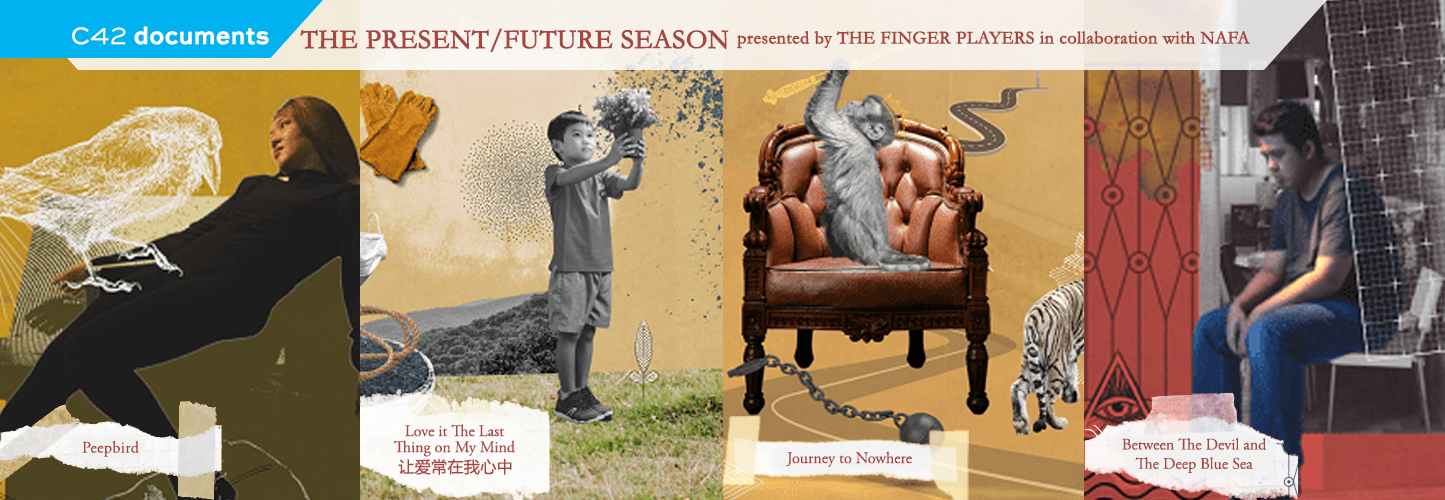
Centre 42 documents the creation process performances of the four productions in The Finger Player’s (TFP) The Present/Future Season. This documentation partnership with TFP aims to capture the inner workings of staging a production, illuminate the working relationships between practitioners and students, and create a textual record of the performance. Each production is documented by two writers, one focused on the performance-making process, and the other on the performance itself. The Present/Future Season was presented by TFP in collaboration with Nanyang Academy of Fine Arts (NAFA), and ran from 7 Oct to 8 Nov 2020.
C42 Documents: The Present/Future Season
[Process] Of First Flights and Transformations: Documenting “Peepbird”
[Process] What is Love?: Documenting “Love is the Last Thing On My Mind”
[Process] The Art of the Seamless Transition: Documenting “Between the Devil and the Deep Blue Sea”
[Performance] “Peepbird”: Decay and transformation
[Performance] “Journey to Nowhere”: Subversive, political take on a renowned classic tale
[Performance] “Love Is the Last Thing on my Mind”: Simple, poignant reminder to love”
[Performance] “Between Devil and the Deep Blue Sea”: From stage to screen

